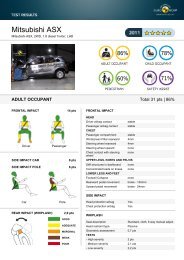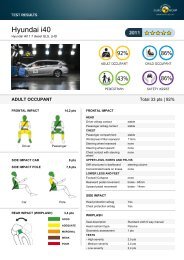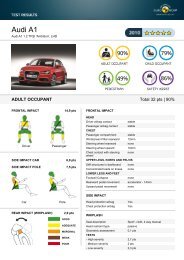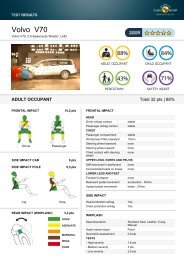Pedestrian Test Protocol - Euro NCAP
Pedestrian Test Protocol - Euro NCAP
Pedestrian Test Protocol - Euro NCAP
You also want an ePaper? Increase the reach of your titles
YUMPU automatically turns print PDFs into web optimized ePapers that Google loves.
selected Bonnet Leading Edge impact points, which will be chosen in Section 6.<br />
11.4.1 Position a horizontal straight edge with one end in contact with the impact point on the<br />
Bonnet Leading Edge Reference Line and measure the vertical distance to the ground.<br />
Alternatively use a 3D measuring arm to measure and record the Bonnet Leading Edge<br />
height for each impact point.<br />
11.5 Determination of Impact Velocity, Impact Angle and Impact Energy<br />
11.5.1 The shape of the front of the car determines the velocity, angle of incidence and<br />
kinetic energy of the impactor. Full details are given in EEVC WG17 Report,<br />
‘Improved <strong>Test</strong> Methods to Evaluate <strong>Pedestrian</strong> Protection Afforded by Passenger<br />
Cars’, December 1998. The velocity, angle of impact and total kinetic energy of the<br />
impactor will be calculated from the bonnet leading edge height and bumper lead.<br />
11.5.2 Determine the Bonnet Leading Edge Height and the Bumper Lead at each impact<br />
point. These can be simply calculated using the previously digitised co-ordinates of<br />
the bonnet leading edge location and its ‘equivalent’ point on the Upper Bumper<br />
Reference line.<br />
11.5.3 Determine the required impact velocity, angle and the kinetic energy for the value of<br />
Bonnet Leading Edge height and Bumper Lead found in 11.5.1 using Figure 26,<br />
Figure 27 and Figure 28.<br />
Version 7.0<br />
March 2013<br />
43
















